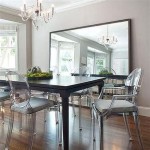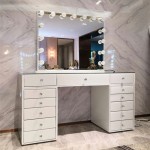What Is A Pier Mirror Used For?
A pier mirror, traditionally, is a large, rectangular mirror designed to stand on the floor, often leaning against a wall or affixed to it. The term "pier" in its historical context refers to the wall space between two windows or other openings. Consequently, these mirrors were initially crafted to occupy these spaces, adding both decorative and functional elements to a room. However, their utility extends far beyond simply filling an architectural niche. Pier mirrors offer a multitude of applications, impacting the aesthetics, light, and perceived space within an interior.
Understanding the multifaceted role of a pier mirror necessitates recognizing its historical development and its evolution in design and functionality. From its origins in European aristocratic homes to its adoption in diverse architectural styles worldwide, the pier mirror has remained a timeless piece of furniture. Its adaptability and potential for enhancing interior design have ensured its enduring relevance.
The primary functions of a pier mirror can be categorized into several key areas. These include amplifying light within a room, creating an illusion of expanded space, serving as a decorative focal point, and providing a practical tool for personal grooming and assessing one's appearance. Each of these functions contributes to the overall value and desirability of a pier mirror in both residential and commercial settings.
Amplifying Light and Brightness
One of the most significant benefits of a pier mirror is its ability to amplify natural and artificial light within a space. Mirrors, by their very nature, reflect light, and the larger surface area of a pier mirror maximizes this effect. When strategically positioned near a window or light source, the mirror reflects the light back into the room, effectively doubling the illumination. This is particularly useful in areas that may lack sufficient natural light or require supplemental lighting to create a brighter and more inviting atmosphere.
The amplification of light extends beyond simply making a room brighter. It can also influence the perceived mood and ambiance. Brighter spaces tend to feel more open, airy, and welcoming, while darker spaces can feel cramped and oppressive. By strategically placing a pier mirror to capture and reflect light, one can dramatically alter the overall feeling of a room, creating a more cheerful and comfortable environment.
Furthermore, the type of light reflected by a pier mirror can also be tailored to suit specific needs. For instance, a mirror placed near a window with southern exposure will reflect warm, natural light, creating a cozy and inviting atmosphere. Conversely, a mirror placed near a window with northern exposure will reflect cooler, more diffused light, which can be beneficial in areas where consistent, even lighting is desired, such as an artist's studio or a home office.
The reflectivity of the mirror itself also plays a role in the degree of light amplification. High-quality mirrors with a clear, reflective surface will reflect more light than those with imperfections or a hazy finish. Therefore, selecting a pier mirror with a superior reflective quality is essential for maximizing its light-enhancing capabilities.
In addition to natural light, pier mirrors can also be used to amplify artificial light sources, such as lamps and chandeliers. By positioning the mirror to reflect the light emitted from these sources, one can effectively double the amount of light in the room, reducing the need for additional fixtures and creating a more energy-efficient lighting scheme.
Creating the Illusion of Expanded Space
Beyond its ability to amplify light, a pier mirror is also a powerful tool for creating the illusion of expanded space. This is particularly valuable in smaller rooms or areas with limited square footage. By reflecting the surrounding environment, the mirror effectively doubles the visual space, making the room feel larger and more open than it actually is.
The psychological effect of this illusion is significant. By creating a sense of spaciousness, a pier mirror can alleviate feelings of confinement and create a more comfortable and inviting atmosphere. This is particularly important in areas where people spend a lot of time, such as living rooms, bedrooms, and even hallways.
The placement of the pier mirror is crucial for maximizing its space-enhancing effect. Generally, placing the mirror on a long wall will create the illusion of greater depth, while placing it on a short wall will make the room feel wider. Experimenting with different placements is often necessary to determine the optimal location for achieving the desired effect.
Furthermore, the objects and features reflected in the mirror will also influence the perceived space. If the mirror reflects a cluttered or disorganized area, it will simply amplify that clutter, making the room feel even more cramped. Therefore, it is important to ensure that the area reflected in the mirror is clean, tidy, and visually appealing. Reflecting a window, a garden view, or an open doorway can significantly enhance the feeling of spaciousness.
The size of the pier mirror also plays a role. A larger mirror will create a more dramatic effect, while a smaller mirror will be more subtle. The choice of size will depend on the size of the room and the desired impact. In general, a larger mirror is more effective in creating the illusion of expanded space, but it is important to ensure that the mirror is proportionate to the size of the room and does not overwhelm the space.
Serving as a Decorative Focal Point and Practical Tool
Beyond its functional benefits, a pier mirror also serves as a decorative focal point in a room. With its large size and often ornate frame, it can add a touch of elegance, sophistication, and style to any interior. The design of the frame can be chosen to complement the overall décor of the room, adding a cohesive and visually appealing element to the space.
Pier mirrors are available in a wide range of styles, from classic and traditional to modern and contemporary. The choice of style will depend on the personal preferences of the homeowner and the overall aesthetic of the room. A traditional pier mirror might feature an elaborate wooden frame with intricate carvings, while a modern pier mirror might have a sleek, minimalist frame made of metal or glass.
The frame of a pier mirror can also be painted or finished in a variety of colors to match the existing décor. A neutral color, such as white or gray, will blend seamlessly with most color schemes, while a bold color can add a pop of visual interest and create a statement piece. The choice of color will depend on the desired impact and the overall design of the room.
In addition to its decorative function, a pier mirror also serves as a practical tool for personal grooming and assessing one's appearance. Its large size allows for a full-length view, making it ideal for checking outfits, styling hair, and applying makeup. This is particularly useful in bedrooms, dressing rooms, and entryways.
The placement of the pier mirror in relation to natural and artificial light is also important for optimizing its functionality as a grooming tool. Ideally, the mirror should be positioned in a location where it receives ample natural light, or where it can be adequately illuminated by artificial light sources. This will ensure that the reflection is clear and accurate, making it easier to assess one's appearance.
The height and angle of the mirror can also be adjusted to suit individual needs. Some pier mirrors are designed to lean against the wall, allowing for easy adjustment of the angle. Others are mounted on the wall, but may have adjustable brackets that allow for tilting the mirror. The ability to adjust the height and angle of the mirror is particularly useful for people of different heights or for those who prefer to view themselves from a specific angle.
In conclusion, the utility of a pier mirror extends far beyond its historical function of filling the space between windows. It is a versatile and functional piece of furniture that can enhance the aesthetics, light, and perceived space within a room. Its ability to amplify light, create an illusion of expanded space, and serve as both a decorative focal point and a practical tool for personal grooming makes it a valuable addition to any home or commercial space. The strategic placement and selection of a pier mirror can significantly impact the overall ambiance and functionality of a room, making it a worthwhile investment for those seeking to improve their interior design.

Pier Mirror The Big And Shiny Mirrors Of Victorian Brooklyn Brownstoner

Pier Mirror The Big And Shiny Mirrors Of Victorian Brooklyn Brownstoner

Pier Glass

Gilt Pier Mirrors Everything You Need To Know From Canonbury Antiques

Pier Mosaic Mirror Styles Of Antique

Gilt Pier Mirrors Everything You Need To Know From Canonbury Antiques

Pier Mirror The Big And Shiny Mirrors Of Victorian Brooklyn Brownstoner

Gilt Pier Mirrors Everything You Need To Know From Canonbury Antiques

New Rule All Furniture Must Reach The Ceiling Victoria Elizabeth Barnes

Decorating Our Victorian Home Via Craigslist








